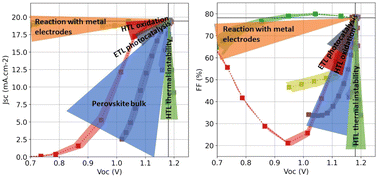Distinction of mechanisms causing experimental degradation of perovskite solar cells by simulating associated pathways†
Abstract
Mechanisms responsible for the degradation of perovskite solar cells are identified by using a novel simulation method. Mutual correlations of current–voltage parameters measured along time are plotted to produce trajectories that are specific to degradation mechanisms and independent from activation processes. In this way, pathways of simulated elementary mechanisms are directly compared to experimental data to identify the dominant cause of performance losses. The results already published in the literature are analyzed to assess the performances of the method. The cause of degradation of devices associated with the latest perovskite solar cell record efficiency is investigated, and insights for further stability improvements are derived. Also, the kinetic approach of a published study is discussed, and the versatility of the method is demonstrated by analyzing the experimental data in sequence with distinct dominant mechanisms. This innovative method focuses on the cause of performance degradation, instead of concomitance with deterioration of material properties. It therefore provides guidance as to which element, such as material or interface, is hampering solar cell stability. This method provides a new way to fruitfully complete, confirm and question degradation studies and interpretations of advanced characterization results.



 Please wait while we load your content...
Please wait while we load your content...